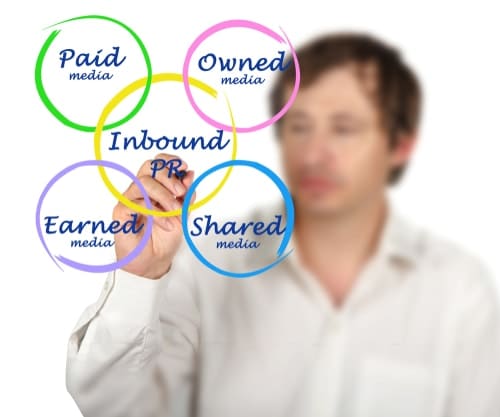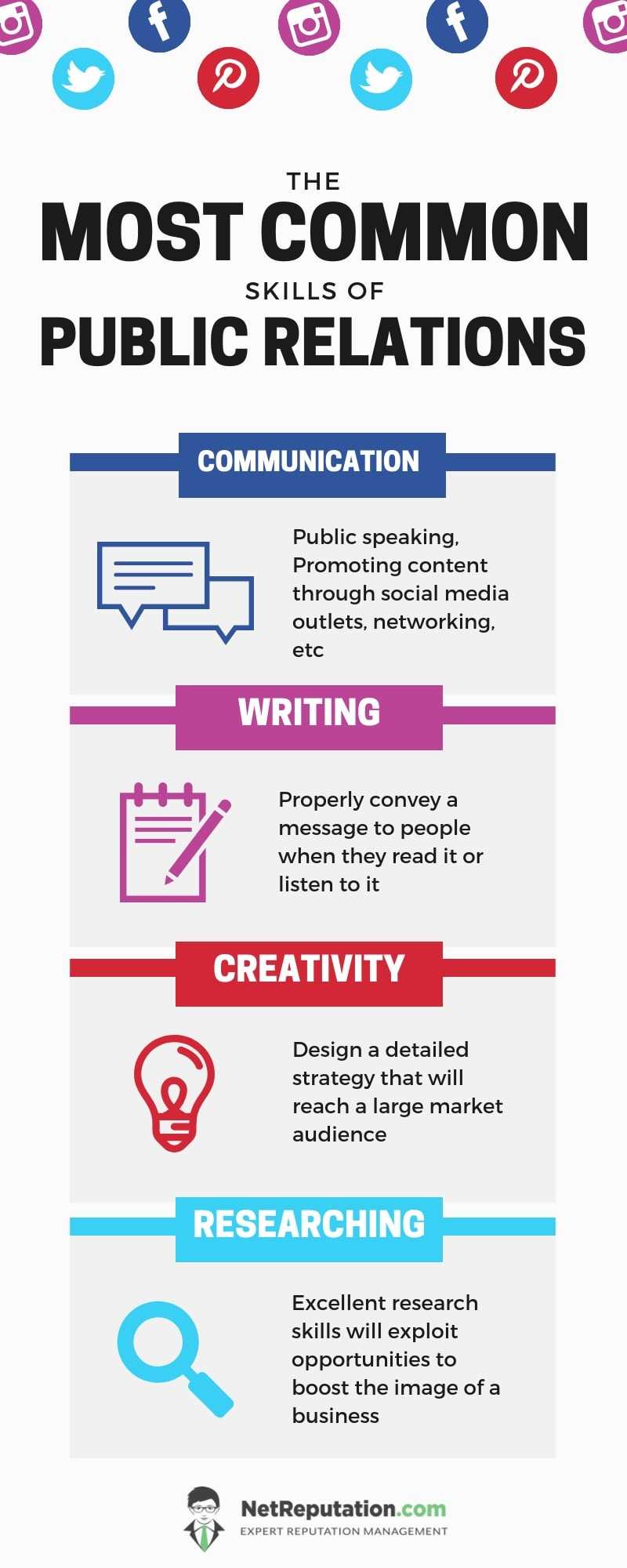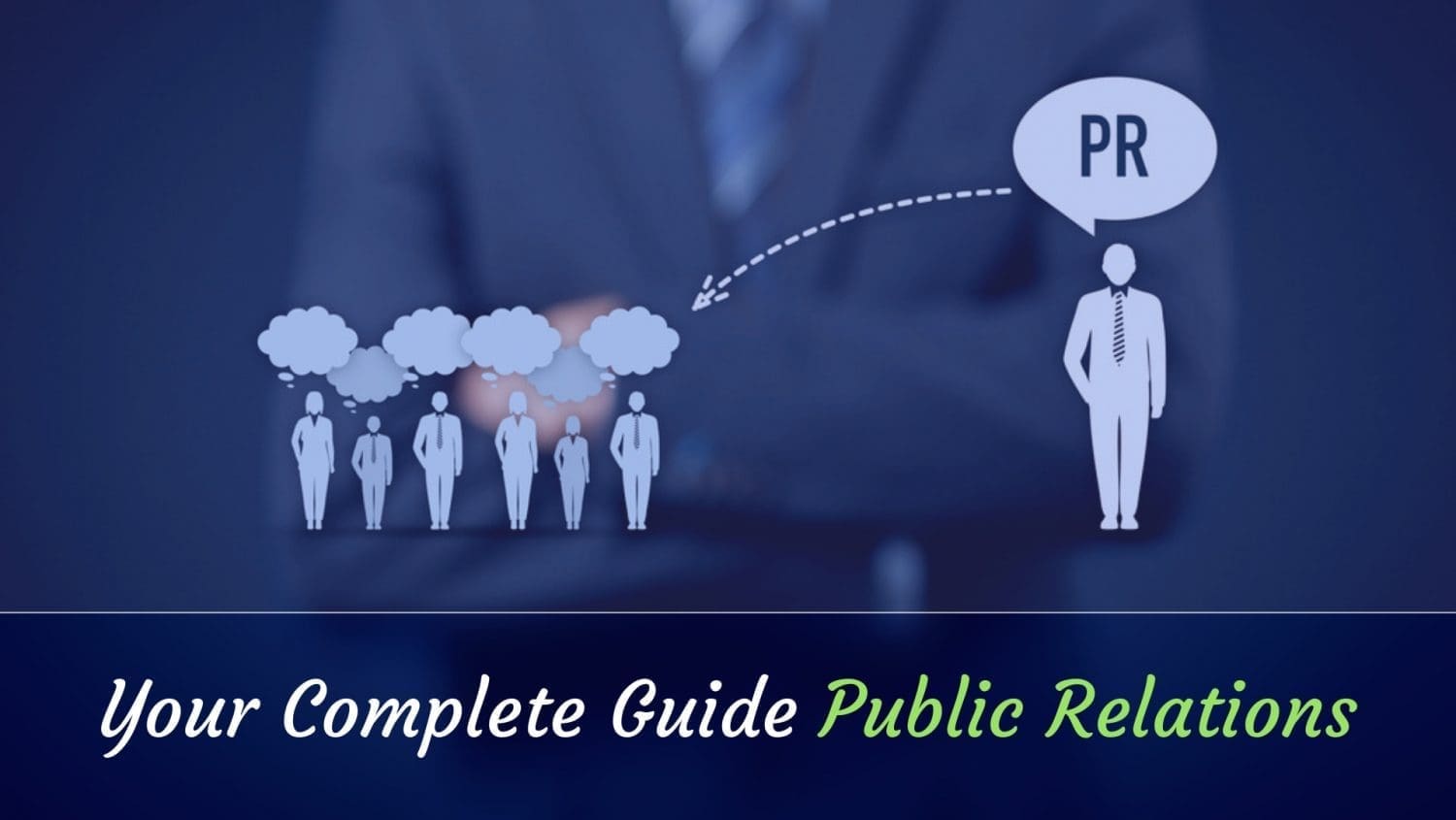Do You Have a Public Relations Strategy?
Are you looking to expand your business opportunities and expose your valued brand to groups of new people who are likely to be interested in what you are offering?
Say hello to public relations.
Public relations (PR) represent the way a company communicates and builds relationships with people. It’s how a company markets its brand.
NetReputation can help you with your communication strategy, allowing you to reach new customers as you reinforce or repair your online reputation.
Public Relations vs. Branding: What’s the Difference?
Communication is the way business brands send information to their target audience, which is similar to branding.
The only difference between PR and branding is that PR is more focused on communication, reputation management, and bringing identity awareness, rather than relying exclusively on visual elements, such as logo designs. It’s all about sending a positive message to people about who you are.
And of course, it’s about more than posting something on social media!
To learn all about PR and how to develop a successful PR strategy for your business or brand, read our detailed PR guide below!
How do PR Efforts Improve My Company’s Reputation?
Working hand in hand with branding and advertising, PR efforts are an extension of your company culture, giving you the opportunity to influence public perception of your business, your products, and your services.
Whether you opt for a traditional press release or engage with followers on social media platforms, PR has the effect of bolstering your positive brand reputation. Effective PR strategies incorporate many factors that tell others who you are, what your company stands for, and how you serve your customers. This information helps to build or reinforce positive relationships between you and your audience.
Remember that your online reputation is a critical aspect of your operation. A favorable public image gives you a competitive advantage. With a strong and positive reputation, you can attract customers, build trust and authority in your industry, and share your brand story by showcasing your core values.
Top 3 Media PR Campaigns
Public relations are divided into three distinct categories: owned, paid, and earned media.
Each one of these PR categories works towards the same reputation-building goal, but each method requires different strategies and action plans to reach that goal.
If you want to have an effective PR campaign, you should be optimizing all three categories listed below.
1. Owned Media
Owned media defines any content that your business controls and is often the go-to strategy for businesses looking to build a PR campaign that enhances their brand and what they represent.
In addition, owned media is the most important type of PR-related media.
That’s right, the most important!
You should focus on this PR-related media because you have the most control, making it the most valuable kind of media (unlike the other two) which represents your business.
Owned media consist of three separate categories:
- Social Media Posts (Facebook, Twitter, Instagram, YouTube, Quora, and many more…)
- Blog Content
- Website Copy
Each of these categories acts as a virtual home for your PR activity.
People writing about your personal brand or products will, more often than not, reference this media in their own coverage, making it a valuable asset to control. As a means of fostering community relations, owned media is the ideal solution.
2. Paid Media
A common standard in the marketing world and a must element in any digital PR strategy, paid media refers to paying to make your content visible.
Used by different online reputation management services and PR professionals to promote media generated by the business itself, this form of media can be done through different services:
- Social media advertising
- Influencer marketing
- Native advertising
- Pay-per-click (PPC)
Financial investment in digital PR content is becoming increasingly popular because through paid media you can communicate your key message to more people. Just like owned media, paid media improves community relations and builds mutually beneficial relationships between you and your customers.
Since the majority of social platforms are reducing organic reach for business accounts, it’s a great way to make sure your content gets to its intended audience — the exact people you are trying to reach.
3. Earned Media
This type of PR strategy can be done through word of mouth or social media – newspapers, Facebook, Instagram, etc.
Defined as a tactic to boost conversation around your brand, earned media is often collected from owned media because it gets people talking about your business.

Earned media, however, is the hardest kind of digital PR strategy to execute.
It takes the most time and effort — from where also the term of “earned” media.
But if you have the resilience and dedication, earned media can be the best way to build your business reputation and brand.
And that’s because if your business, product, or services are:
- Reviewed on industry blogs
- Praised in customer testimonials on social media
- Ranked on Google in front of your competition.
… it’s bound to make a lasting impression on your prospects!
Media mentions of your brand online, or industry news shared on your behalf, have the benefit of improving your search engine optimization by boosting your visibility in search results.
PR vs. Marketing
Although marketing and PR strategies are very similar in their approach, each one has different goals.
The main goal of public relations is to boost the reputation of your brand through different strategies. This doesn’t always translate into more sales, and it typically includes indirectly promoting your brand through activities, such as press release writing or speaking at industry events.
On the other hand, the main goal of a marketing campaign is to boost sales. Instead of improving someone’s perception of your business, marketing teams focus on driving revenue and boosting profits.
PR and inbound marketing are closely related, and using them together can achieve the best results. When you invest in marketing, public relations is the next logical step on your journey to gaining improved visibility and brand awareness.
That’s because people don’t buy products, they buy brands.
If someone is willing to buy your product (because of marketing strategies), it means they’re already connected with the brand (through press releases, media outreach, and social media engagement.
This explains why the average revenue increase attributed to consistently representing a brand is 23%. You would see similar results if you combined both strategies.
Put together, marketing and PR strategies are the perfect combo for the success of any business!
Inbound PR Strategy
Inbound has been rightly named the future of PR. It combines PR’s greatest strength (content) and inbound (measurement) so you can prove the ROI of your PR strategy in order to optimize your business.
Inbound PR works so well because you can see what’s working, and equally important, what’s not.
For example, if your business was struggling to collect backlinks from your coverage, the inbound PR approach would allow you to identify this and tweak your future strategy.

This insightful presentation by Iliyana Stareva, first presented at the Inbound 2016 conference, shares everything you’ll need to know about inbound PR and how you can tweak your strategies.
Inbound PR is a dependable and reliable way to build your brand, generate leads, and convert those leads through your public relations strategy.
Simply put, inbound PR is the future!
What Does A Public Relations Manager Do?
As public relations professionals, PR managers enhance content and supervise the development and proper execution of your business’s PR strategy.
The typical day in the life of a PR manager, no matter if working in-house or as an agency, consists of strategizing content to promote the image of a particular business
Main Activities of PR Professionals:
Standard day-to-day tasks of a PR manager can vary greatly but mostly focus on:
- Writing press releases for company-related information.
- Creating fact sheets about the company to be sent to media teams to build their brand.
- Providing media training to both in-house and external teams.
- Speaking at business events.
- Finding and analyzing media coverage in order to promote that content through owned and paid media outlets.
- Attending industry events to positively represent the brand at trade shows, recruiting events, etc.
Common Skills Of PR Managers
Successful PR managers not only have foundational skills, but are especially skilled in public speaking and media relations.
The following skills are essential for public relations success in any public relations position:
Great Communication
Public speaking, promoting content through social media outlets, networking, etc.- all require great communication and are essential for building your business’s reputation.
PR managers will spend the majority of their time effectively communicating and promoting a business. That’s why excellent communication is such a valuable skill for any PR manager to have.
Writing Skills
Besides having valuable communication skills, PR managers should also be well-versed in writing.
Writing press releases and company-related news requires writing skills that are able to properly convey a message to people when they read it or listen to it. That is why PR Managers must possess impeccable writing skills if they are to effectively promote their business.
This is especially important when PR Managers promote their business through blog posts, website content, and press releases. To get the most from social media engagement, well-written content is crucial.
Creativity
Just like in marketing, creativity can go a long way in the public relations world when looking to promote a business.
The most effective PR managers are both creative and also know how to build the right PR strategy to reach a wide audience.
Not only will the creativity skill help PR managers in “boring” industries, but it will also drive earned PR coverage. If you can craft a unique spin on a story, it will attract a wide audience that will be engaged in what you have to say.
Strong Research Skills
An important part of a PR strategy is based on researching and understanding how people communicate. Exploiting these findings can boost the image of a business. Every strategic communications process is built on a foundation of audience research.
PR managers will also need to do research when planning their strategy. For instance, they might need additional information, statistics, case studies, and data points to boost the power of their owned media, in which strong research skills are essential.

Public Relations Infographic
The Goals Of Public Relations Campaigns
Goals are the measure of success for any PR campaign.
Here’s a list of key performance indicators (KPIs) that you should always have when determining the effectiveness of your PR strategy.
(They also follow the inbound PR methodology which is a plus!)
Brand Mentions
Brand mentions are almost self-explanatory.
They are created when someone mentions your brand in any way in their earned media coverage. Most often they come out when news publications cover your story, without linking back to your website.
Brand mentions are great for promoting brand awareness, but there’s just one particular issue with brand mentions – they can be difficult to track.
Fortunately, tools like Mention scan the internet for any reference for your business’s name. These online tools can help you find out how many people covered your PR campaign and where they covered it.
Usually, a high number of brand mentions means a successful PR strategy because your brand gets to be promoted through word-of-mouth. Essentially, word of mouth mentions boost visibility across digital platforms.
But people talking about a brand does not always translate into instant success. They should be talking about good things for it to be deemed successful. Who is doing the talking is also important; while traditional media holds an important role, media influencers on social networks have gained value in the PR industry. Media influencers have an outsized effect on social media due to their large audience base. Search engines pick up on these mentions, positively influencing rankings in search results.
Earned coverage in the media will sometimes mention how awful your brand is, without any mention of what is good about it. That’s why understanding the context and what people are saying about your brand is important.
However, you must ensure you have the proper reverse SEO strategies in place when working to suppress negative content
Reputation Management
You can effectively manage reputation with a solid PR campaign. From a simple press release to a more comprehensive set of initiatives like earned and paid media, visibility in the online environment influences customer purchasing decisions. If you are able to build a positive reputation with your target audience, new opportunities for business growth and revenue present themselves.
Conversely, if your reputation is negative, you may be missing out on these opportunities. As a core component of media relations, PR works to rebuild or repair a reputation damaged by negative information in search results.
Backlinks
Related to brand mentions, backlinks guide you to where your PR story has been discussed. The sites that have mentioned your brand will have links to your website, making it easy for readers to find your website and the original content.
You’ll not only benefit from new visitors when collecting backlinks from PR coverage, but you will also see a rise in your SEO rankings, too.
Site Traffic
Signs of a successful PR strategy campaign are when people are discussing positively your brand and are visiting your site through earned media.
To replicate the success of your previous PR campaign, track the number of visitors that have visited your site compared to your previous campaign.
Do the research, figure out where they came from (was it a particular piece of coverage?) and aim to replicate this success in your future PR campaigns.
New Customers
It is difficult to measure exactly how many new customers came as a result of your PR campaign. But if you were successful in attracting new customers and increasing sales in your previous campaigns, investigate and research in order to produce the same positive results.
To see where customers came from you can:
- Survey customers after they made a purchase and ask them where they heard of you.
- Use Google Analytics conversion paths to find their route to purchase.
Attracting new customers as a result of your public relations strategies addresses your success.
For those who don’t see an immediate influx of conversion-ready site traffic, don’t get discouraged.
The goal of PR is to promote brand awareness, spread your internal thought leaders’ ideas, and communicate those ideas through your brand through PR strategies.
If you are doing all of these activities, there’s a high chance you will get both returning customers and new customers to purchase your products.

A Word About Corporate Responsibility
In today’s modern business environment, where a given company stands on social and environmental issues can have profound influences on consumer behaviors. This is referred to as social and corporate responsibility. In essence, ethical business practices are a must-have for modern business owners; customers demand this type of corporate stewardship.
PR allows companies to share their positions with a target audience. For example, you can share your company’s work in adhering to environmental responsibility practices with a unique and exclusive story about achievements your team has made in reducing waste or eliminating environmental hazards.
Social responsibility takes many forms. For modern companies, a policy of inclusivity and fairness in business functions can help build or support your online reputation. Among public relations tools in the private sector, being responsible in social, environmental, and corporate practices has tremendous value. A quality PR firm will leverage this responsibility in marketing materials and in traditional PR output such as press releases or media events.
Public Relations Strategies And Tools
If you are looking for PR guidance or a way to improve your PR skills, look at these helpful resources below.
These six excellent public relations strategies will provide you with a basis to understand public relations:
- CoverageBook: Use this tool to find and collect any coverage of your PR content. It’s a great tool for PR agencies that are building coverage reports for their clients.
- Mention: Tracks who’s mentioned your brand in earned media coverage.
- Monitor Backlinks: Tracks who’s mentioned your brand in coverage and included a backlink to your site.
- Muck Rack: Collects details of media people who might be interested in covering your PR story.
- PR Fire: Takes tedious PR tasks off your hands. It’s a fantastic tool for in-house teams who’re doing their own PR.
- Agility PR Solutions: Provides powerful yet easy-to-use media database, monitoring, and analytics solutions to help identify and connect with influencers, capture coverage, and measure impact.
CONCLUSION
It’s time to start reading, learning, and taking the first steps to strategize for the future and become a PR guru.
We can’t wait to read about your successful brand in the news!
There’s, however, one thing you should keep in mind:
PR is an ongoing and long term strategy, and not a one-off task, for both PR and marketing departments.
But don’t give up!
As with anything that takes dedication, it can take a while to see results. One press release will start you on the road to a strong reputation and great visibility, but only time and hard work will propel you to the next level in your business.
Contact NetReputation Today
With a solid strategy and a commitment to learning strategies about getting people to talk about your company, you’ll soon see more mentions, backlinks, and a general buzz.
In conclusion, it all starts now. Contact us today and let’s get started on making your brand memorable. Call NetReputation at 844-461-3632 or fill out the form below to receive a free consultation.
